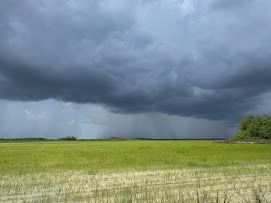Working for Audubon has been quite the privilege, and with this privilege there are some perks.
Throughout my time here at Corkscrew I have been able to volunteer for some great research projects through the Corkscrew connections. Through one of these connections I was able to volunteer for Audubon Florida's shorebird stewarding program in the Big Marco Pass Critical Wildlife Area.
 |
| Volunteers: Amanda, Melissa, Brittany |
Every weekend the Audubon FL shorebird steward Col goes out on two shifts every Saturday and Sunday where she monitors the nesting shorebirds along Tigertail beach. I have had the chance to go out a couple times to assist in monitoring, and thanks to Col and the stewardship program I have learned a lot about shore birds in the process.
 |
| Audubon FL Shorebird Steward Col monitoring Black Skimmer colony |
 |
| Least Tern colony |
This season there have been Least Tern and Black Skimmer colonies, however, both colonies have had a rough nesting season on the beach that Col monitors. Earlier in the season the Least Tern's started to nest on a beach by Key Waydin, however, Tropical Storm Alberto hit SWFL in the end of May and completely wiped out the Least Tern nesting area. Thankfully the Least Tern's showed resilience and attempted to nest once again on Tigertail beach, which was looking to be successful, however, crow's started to predate on their eggs and nestlings. This island has had a huge negative impact caused by the crows coming from Marco Island. The crows will predate on shorebird eggs and nestlings and can easily decimate a nesting colony. Unfortunately once the Least Terns re-nested on Tigertail, their nests were predated by huge numbers of crows, and also burrowing owls, and thus this season was a failure for this Least Tern colony. After all the trials and tribulations that the Least Tern's went through the adults abandoned the colony and left. I was able to see the Least Tern colony in June post Alberto when they decided to give nesting another go, and I was hopeful that they would be able to fledge some young. I hope that the Least Tern's are able to have a better nesting season next year, and I look forward to seeing if they are successful next year.
 |
| Black Skimmers |
On the same island, there is a decent sized Black Skimmer colony who have been able to produce many nestlings. It has been a treat to see the Black Skimmers sitting over their nestlings, and to also see both parents explore the colony area with their young. Despite the Black Skimmer colony having greater success compared to the Least Tern colony, they are still having their nests predated by crows. Col told me about the times she has seen crows pick off Black Skimmer fledglings one by one in the colony. I was volunteering this past weekend on July 14th and the amount of crows I saw swooping down into the Black Skimmer was beyond nerve wracking. Thankfully during my shift I did not see any crows fly away with a Black Skimmer fledgling, however, they are a threat all day and I do not doubt that the crows were successful in eating some fledglings.
 |
| Black Skimmer on fledgling |
 |
| Two Black Skimmer fledglings in nest |
 |
| Black Skimmer on nest |
 |
Black Skimmer with two fledglings
|
The crow situation on Tigertail Beach is something that needs to be taken care of before the next shorebird nesting season begins. After talking to Col a bit it really seems like Marco Island has a huge crow problem due to trash cans being left open, and unfortunately many of these crows have learned that if they fly to this nesting beach they can easily get a shorebird nestling meal. There needs to be more exposure about the crow problem to the citizens and businesses of Marco Island.
Besides crows, there are other predators out on the beaches such as burrowing owls, ghost crabs, and humans. I have realized how important it is for humans to leave a nesting area that is roped off alone. People don't realize how important these nesting colonies are for shorebird populations.
I have a little over a month left at Corkscrew and it is a bittersweet feeling. For all future interns that pass through Corkscrew, I highly encourage you to take advantage of the all the connections that Audubon has to offer. There are so many great volunteer opportunities around Corkscrew and SWFL so get out there, and learn some cool things.
-Intern Melissa























